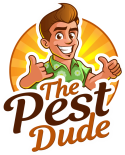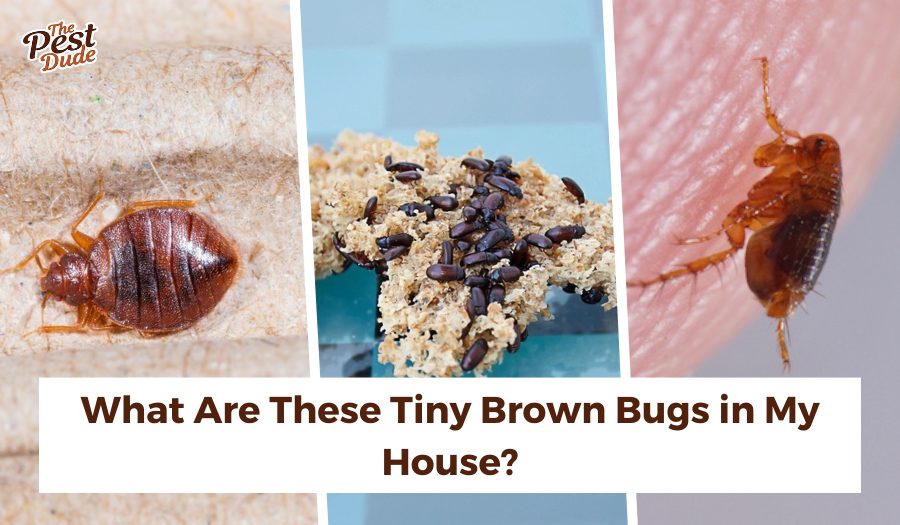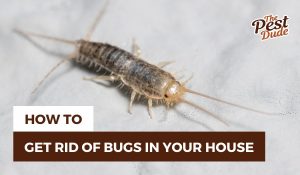Discovering small brown bugs in various corners of your home can be alarming.
As a homeowner, it’s important to understand what these little intruders are, the risks they pose, and how to effectively deal with them.
In this blog, we’ll share our top tips for helping you identify and eradicate the pests and reclaim your space!
Key Takeaways
- If you have tiny brown bugs in your home, identify them based on their appearance and location.
- The most common types of brown bugs that invade homes are drugstore beetles, silverfish, weevils, cockroaches, ticks, bed bugs, bat bugs, fleas, and stink bugs.
- If your DIY efforts have failed or you need more help getting rid of bugs, contact a pest control professional in your area.
Common Small, Brown Household Bugs
1. Drugstore Beetles
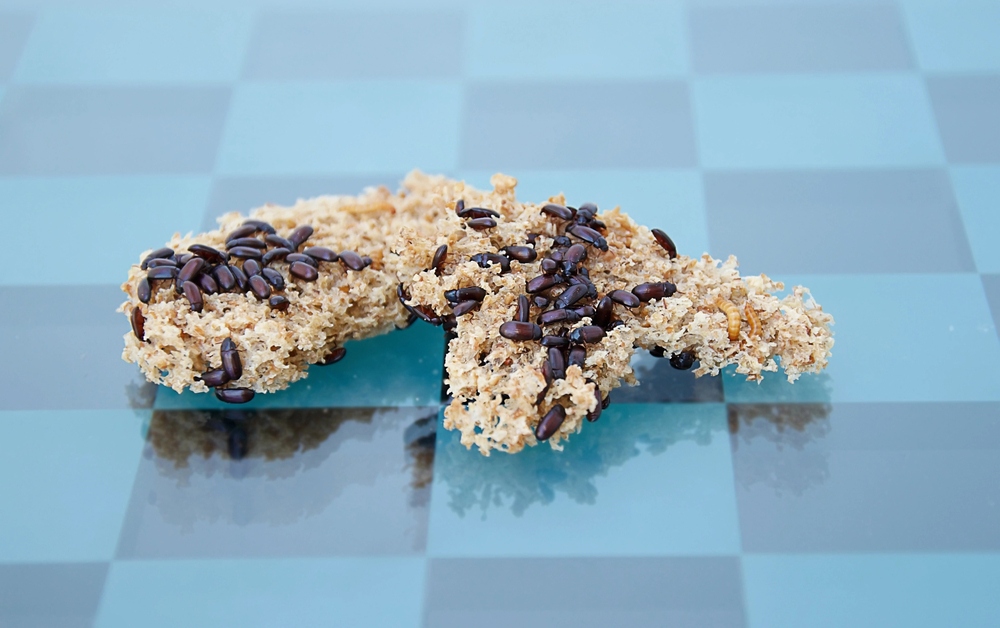
Identification
Drugstore beetles, often confused with cigarette beetles, are small, brown, stored product pests.
They have a rounded shape with hard wing covers.
Drugstore beetles are most commonly found in areas where food is stored.
This includes kitchens, pantries, and places where food is kept in large quantities, such as grocery stores or warehouses.
They are particularly attracted to flour, cereals, spices, and other dry food items.
Health Risks
While drugstore beetles don’t pose significant health threats and are not known to spread diseases, they can contaminate dry foods, rendering them unfit for consumption.
Extermination
Keep pantries clean, discard contaminated food, and use pheromone traps to get rid of drugstore beetles.
2. Silverfish
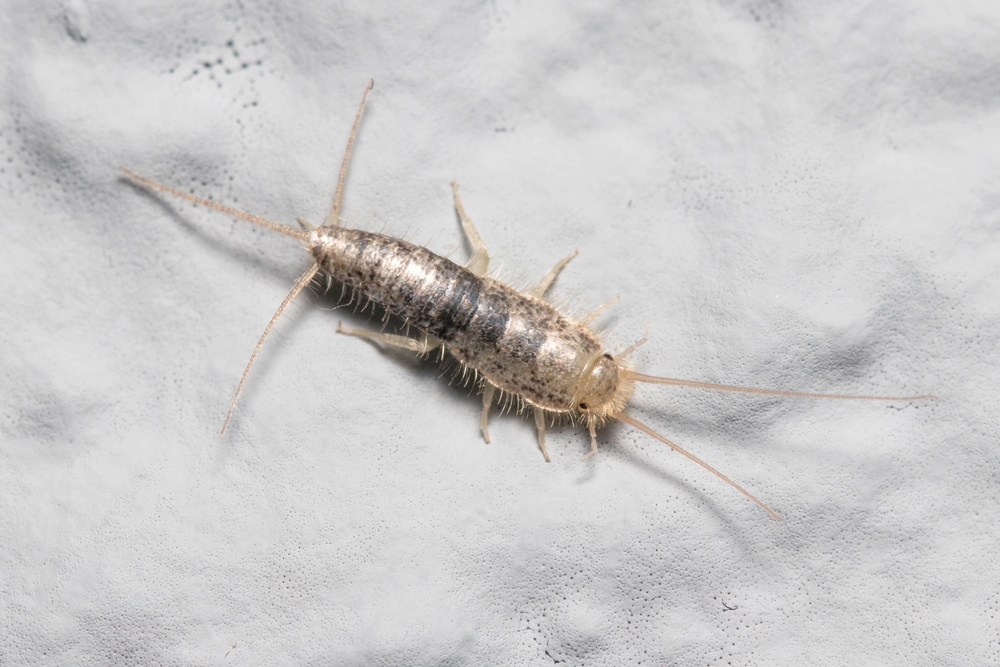
Identification
Silverfish are shiny, silver or brown, teardrop-shaped insects.
Silverfish are most commonly found in humid, moist environments.
They thrive in areas such as bathrooms, basements, attics, and kitchens.
They are nocturnal creatures and tend to hide in dark, secluded spaces during the day, often within walls, behind baseboards, or in storage boxes.
These pests are attracted to paper and damp clothing, and it’s common to find them lurking in old books, newspapers, and in the laundry room.
Health Risks
Silverfish don’t bite humans or animals and are not known to carry diseases.
However, they may trigger allergies in some people.
Extermination
Reduce humidity, vacuum regularly, and use desiccants or bait traps to kill silverfish.
3. Weevils
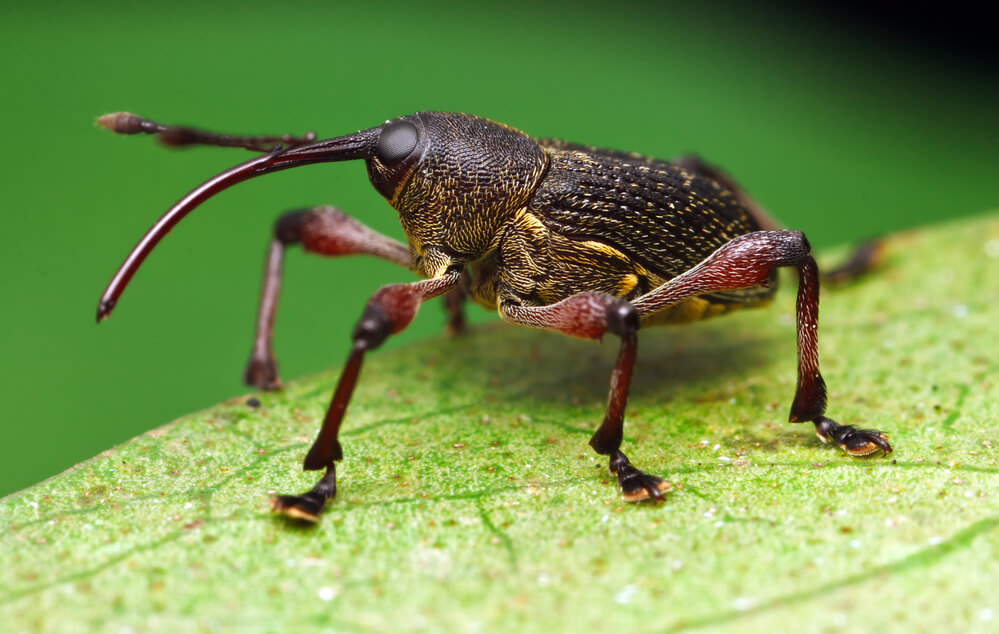
Identification
Weevils are small beetles with noticeable snouts.
They tend to be lightbulb- or pear-shaped and are known to enter buildings by crawling through cracks, openings, and gaps around doors and windows.
Weevils, like many pests, are often found in areas where food is stored.
They have a particular fondness for grains and dried goods, making your kitchen, pantry, or anywhere else you store these items a prime target for infestation.
This can include places like supermarkets and warehouses, which have large amounts of food stored.
Health Risks
Like drugstore beetles, weevils do not bite or spread diseases.
That said, they can destroy stored foods and render them unfit for human consumption.
Extermination
Inspect all grains, store food in sealed, pest-proof containers, and use traps specific to weevils.
For more information on how to get rid of weevils, check out our guide to eliminate pantry bugs.
4. Cockroaches
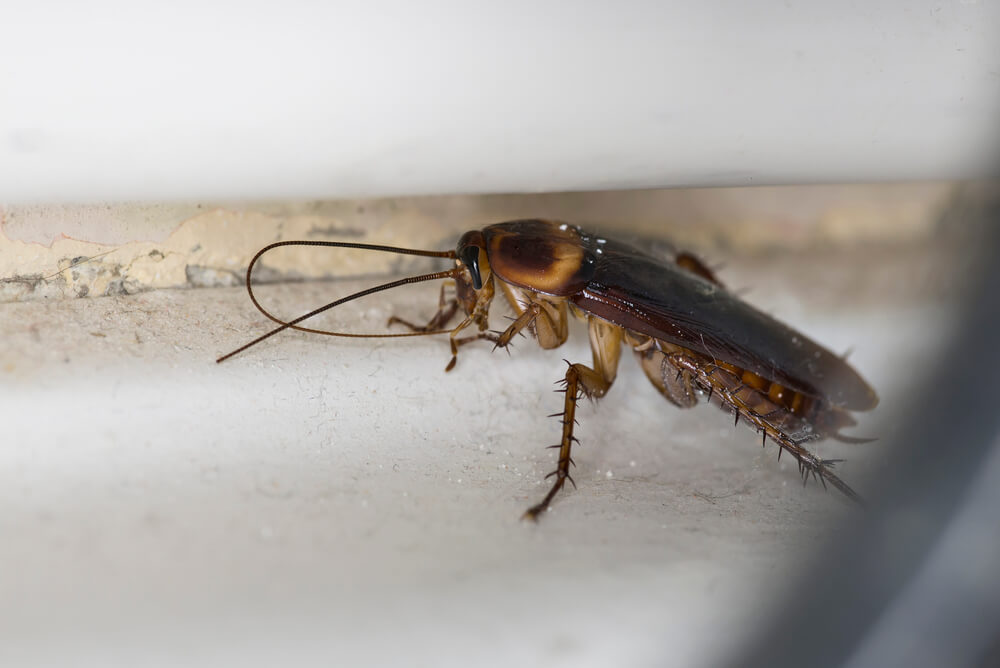
Identification
Cockroaches vary in size and color but are commonly dark brown with a flattened, oval body, long antenna, and six strong, spine-covered legs.
These are fast-moving bugs that are most active at night.
Cockroaches are typically found in areas that are warm, dark, and damp, as these conditions are ideal for their survival.
They are often found in kitchens, bathrooms, and basements, where they have access to food and water.
In urban environments, they can also be found in sewers and drain systems.
Regular cleaning and proper maintenance of these areas can significantly help in preventing a cockroach infestation.
Health Risks
Cockroaches can carry diseases that cause food poisoning or diarrhea, while their saliva, feces, and cast skins can trigger allergies or asthma.
Extermination
Maintain a clean home, seal entry points, and use baits, traps, or pesticides.
For severe cockroach infestations, hire a professional exterminator for assistance, or read our comprehensive guide on how to get rid of cockroaches.
5. Ticks
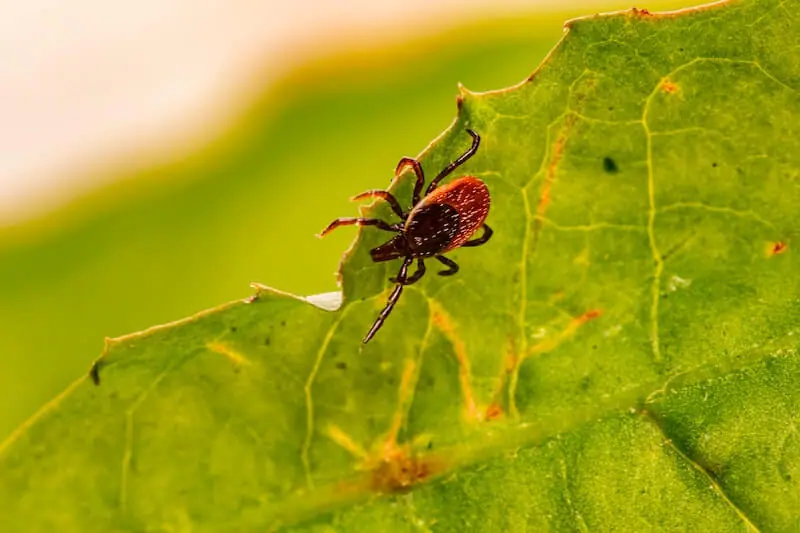
Identification
Ticks are tiny, spider-like arachnids that are known for attaching themselves to people and pets.
They have two primary body parts: a cephalothorax and an abdomen and scissor-like mouthparts designed to pierce the skin of their victims.
Ticks are most commonly found in areas with warm, humid climates, as they require a certain level of moisture to survive.
They thrive in tall grass, brush, and wooded areas where they can easily latch onto passing hosts for a blood meal.
This includes forested areas, overgrown fields, and even your backyard if it’s not regularly maintained.
Health Risks
Ticks carry a wide variety of diseases, including Lyme disease, anaplasmosis, ehrlichiosis, Rocky Mountain Spotted Fever, and Tularemia.
Extermination
Keep grass short, use tick repellents, and check for ticks after spending time outdoors.
For more information on how to get rid of ticks, check out our complete blog on the topic.
6. Bed Bugs
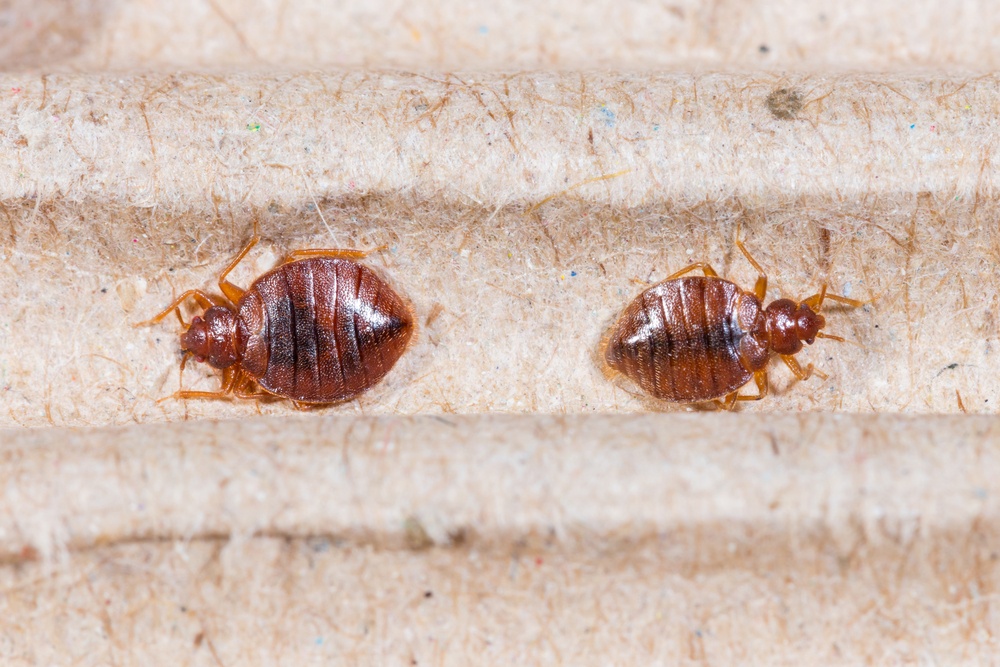
Identification
Bed bugs are reddish-brown in color with flat, oval bodies.
They hide in mattress seams or furniture joints, especially where people sleep. They feed on blood and are known to bite people and pets.
Bed bugs are most commonly found in areas where people sleep or spend significant periods of time.
This includes bedrooms, particularly in mattresses, box springs, bed frames, and headboards.
They can also be found in other types of furniture, wallpaper, and even clutter around your home.
Bed bugs are excellent hitchhikers and can easily spread from room to room, or even between apartments in a building.
Health Risks
While bed bugs feed on blood, they are not known to spread any diseases to humans.
Their bites do, however, cause itching and skin rashes.
Extermination
Use bed bug-proof mattress covers, vacuum regularly, and consider professional extermination.
For more information on how to get rid of bed bugs, check out this comprehensive guide.
7. Bat Bugs
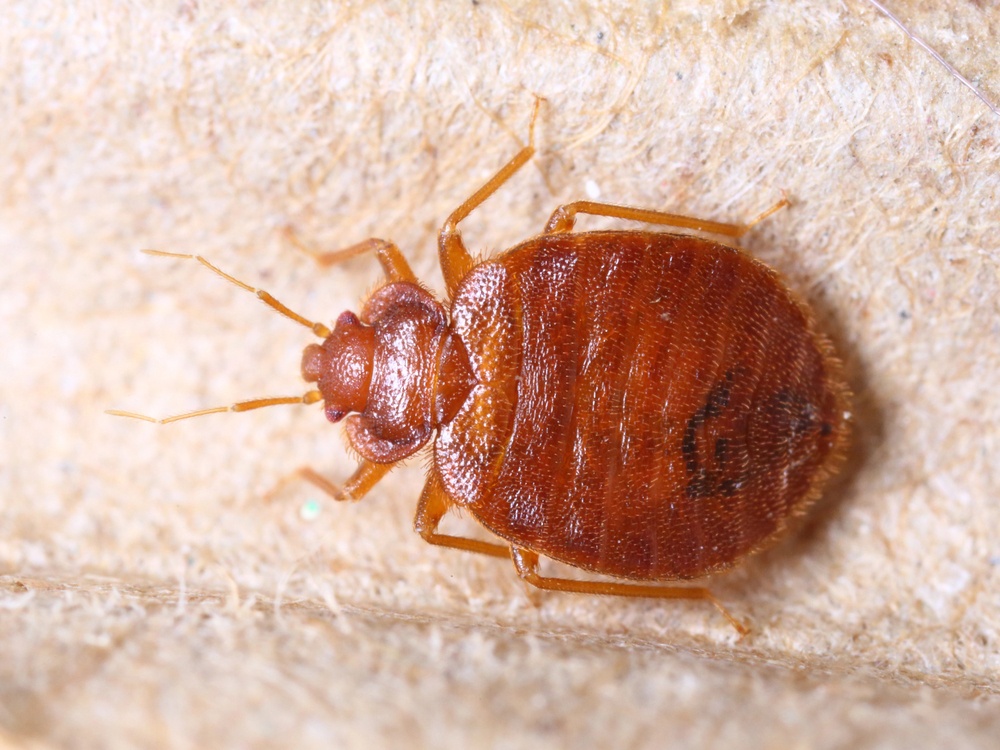
Identification
Similar in appearance to bed bugs, bat bugs have short, broad heads and are known to live entirely with humans.
Bat bugs, similar to bed bugs, are most commonly found in areas where people sleep.
Health Risks
Bat bugs are not known to be dangerous to humans or animals.
While their bites can cause irritation and discomfort, they do not transmit diseases.
Extermination
Remove bat infestations safely and treat the living spaces to remove any remaining bugs.
8. Fleas
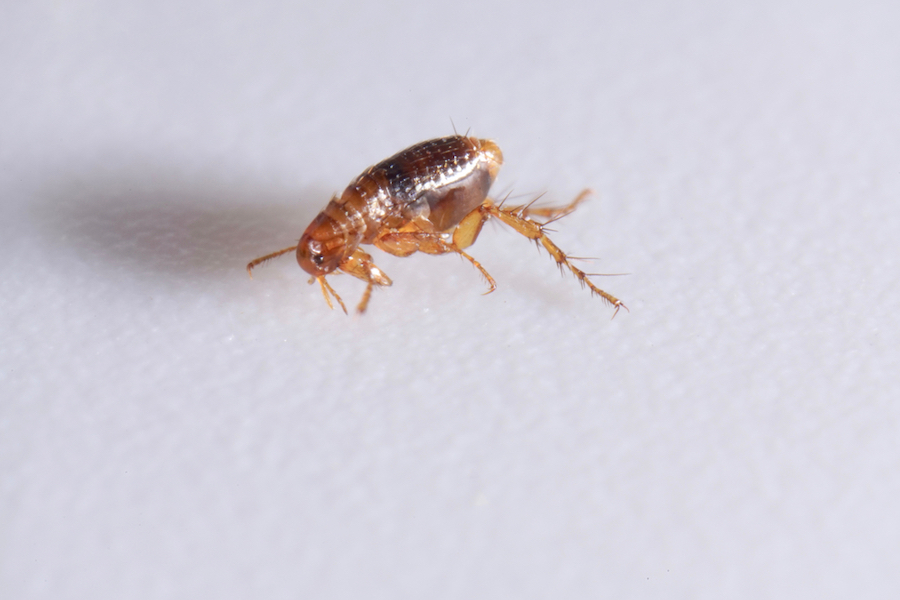
Identification
Fleas are tiny insects that are known to jump high, travel quickly, and feed on human and animal blood.
Fleas are most commonly found in areas where pets rest and sleep, as these parasites are often brought into the home by dogs and cats.
This can include places like pet bedding, carpets, furniture, and even outdoor areas where your pet spends time.
Fleas lay their eggs in these areas, which can lead to a full-blown infestation if not addressed promptly.
Health Risks
Fleas can transmit diseases like flea-borne typhus, plague, and cat scratch fever. Their bites may also cause irritation, itchiness, and discomfort.
Extermination
Treat pets with veterinary-approved flea control products, clean living spaces thoroughly, eliminate other pest populations, use a HEPA vacuum in your home, and use indoor insecticides and IGRs to provide long-term control.
For more information on how to get rid of fleas, check out our comprehensive guide.
9. Stink Bugs
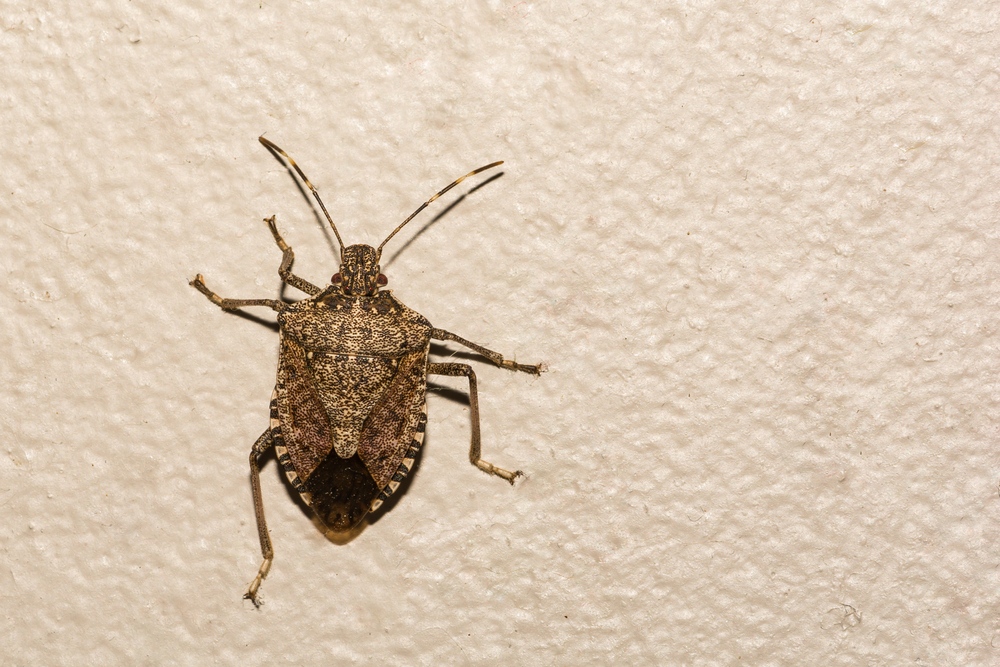
Identification
Stink bugs are easy to identify by their shield shape and the unpleasant odor they emit when disturbed.
They commonly invade homes in the fall, when they come inside looking for warmth and shelter.
Stink bugs are most commonly found in outdoor environments like gardens and farms, where they feed on plants.
Inside, they tend to reside in quiet, undisturbed areas such as attics, wall cavities, and behind baseboards.
However, they are also known to cluster on the sunny exterior walls of buildings in the fall.
Health Risks
Stink bugs are primarily a nuisance pest rather than a health hazard.
They do not bite and are not known to spread diseases or cause physical ailments for humans or pets.
Extermination
Seal possible entrances and use pesticides if necessary.
For more information, check out our guide on how to get rid of stink bugs.
10. Carpet Beetles 
Identification
Carpet beetles are small, oval-shaped insects that can be black or shades of brown.
They usually have unique patterns on their bodies, which makes them easier to identify.
Adult beetles are about 1/8 to 3/16 of an inch long, while their larvae can grow up to 1/4 inch. They have six legs and antennae.
Health Risks
Carpet beetles aren’t harmful to people, but their larvae can trigger allergic reactions and skin irritation.
They can also damage fabrics and other materials in your home.
Extermination
Thorough cleaning is essential for eliminating carpet beetles in your home.
Vacuum carpets and upholstery regularly, wash fabrics in hot water, and consider using insecticides designed to target and kill carpet beetles.
11. Booklice (Psocids)
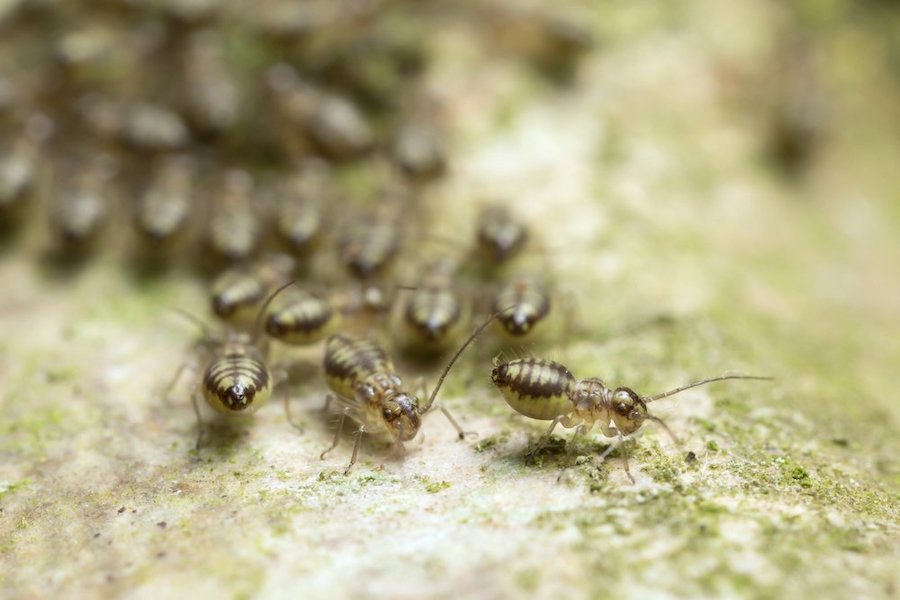
Identification
Booklice are small, soft-bodied insects that usually appear in light brown or tan colors.
These tiny creatures thrive in damp environments, where they often go unnoticed.
Due to their size and coloration, they can easily be mistaken for dust specks.
Health Risks
Booklice are generally harmless, but they can indicate the presence of moisture problems in your home.
Extermination
Control moisture levels in your home, use dehumidifiers, and ensure proper ventilation to deter booklice infestations.
12. Fungus Gnats
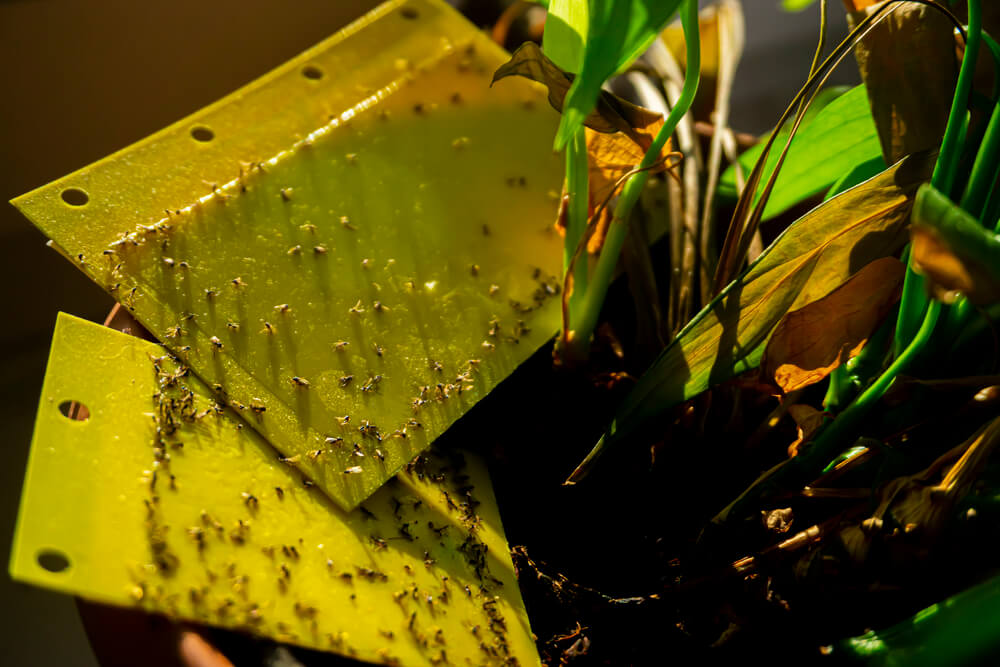
Identification
Fungus gnats are small insects with dark wings that closely resemble tiny fruit flies.
These pesky little creatures are commonly found near houseplants and moist soil.
They thrive in environments with a lot of organic matter and high humidity, making them a frequent sight in homes with indoor plants.
If you notice these insects flying around your plants, it’s a sign that the soil may be too wet or that there’s decaying organic material present.
Understanding their behavior can help you manage and prevent infestations effectively.
Health Risks
While fungus gnats are not harmful to humans, their larvae can damage plant roots and hinder plant growth.
They can also spread plant diseases, which is why it’s essential to control their population.
Extermination
To get rid of fungus gnats, reduce moisture levels in the soil by allowing it to dry out slightly between waterings.
You can also use natural predators like nematodes or sticky traps to control their numbers.
Ensuring proper drainage and using sterile potting soil for your plants can also help prevent infestations.
13. Spider Beetles

Identification
Spider beetles are tiny, round insects that can be reddish-brown or black.
With their long legs and antennae, they look a bit like spiders.
These pests often hide in stored food and can contaminate pantry items if not dealt with.
Health Risks
Similar to weevils, spider beetles are not known to pose significant health risks to humans.
However, their presence in stored food can create problems.
When spider beetles infest food supplies, they can contaminate it with insect parts or feces.
Extermination
Preventing spider beetle infestations starts with proper food storage practices.
Keep dry goods in sealed containers and regularly check for signs of infestation, such as webbing or damaged food packaging.
Removing and disposing of any affected food items is recommended if an infestation is detected.
Professional pest control services may also be necessary for severe or recurring infestations.
14. Fruit Flies

Identification
Fruit flies are tiny, brownish flies often found around overripe or decaying fruit.
They are attracted to sugary and fermenting substances, making them a common nuisance in kitchens, garbage cans, and recycling bins.
Fruit flies have a distinctive appearance with large red eyes and transparent wings.
Although they may seem harmless, their rapid reproduction rate can result in large populations if left unaddressed.
Health Risks
Fruit flies do not bite or spread diseases but can contaminate food with bacteria from the surfaces they land on.
This can lead to foodborne illnesses such as diarrhea and vomiting.
Additionally, their presence can indicate unsanitary conditions in your home or business.
Extermination
The key to controlling fruit fly infestations is eliminating their breeding and food sources.
This includes regularly disposing of overripe or decaying fruit, cleaning up spills and crumbs, and keeping trash cans and recycling bins clean.
Homemade traps using apple cider vinegar can also effectively reduce their numbers.
In severe cases, professional pest control services may be necessary to eradicate the infestation.
They can also help identify potential entry points for fruit flies and provide guidance on preventing future infestations.
15. Brown Marmorated Stink Bugs (Nymphs)

Identification
Brown marmorated stink bugs are small, shield-shaped insects with a distinctive brown and gray coloration.
They have six legs and antennae and, during their adult stage, can range in size from 12 to 17 mm.
Nymphs, or immature stink bugs, are smaller and lack wings.
Health Risks
Stink bugs do not bite or spread diseases but can produce a strong odor when crushed or threatened.
Additionally, they can damage plants by sucking out their insides, leading to wilted leaves and reduced crop yields.
Extermination
Preventing stink bug infestations begins with sealing off any cracks or openings in your home that they could use as entry points.
This includes gaps around windows and doors, utility pipes, and vents.
Insecticides can also be used to treat infested areas, but it is best to consult a professional pest control service for safe and effective methods.
16. Clover Mites
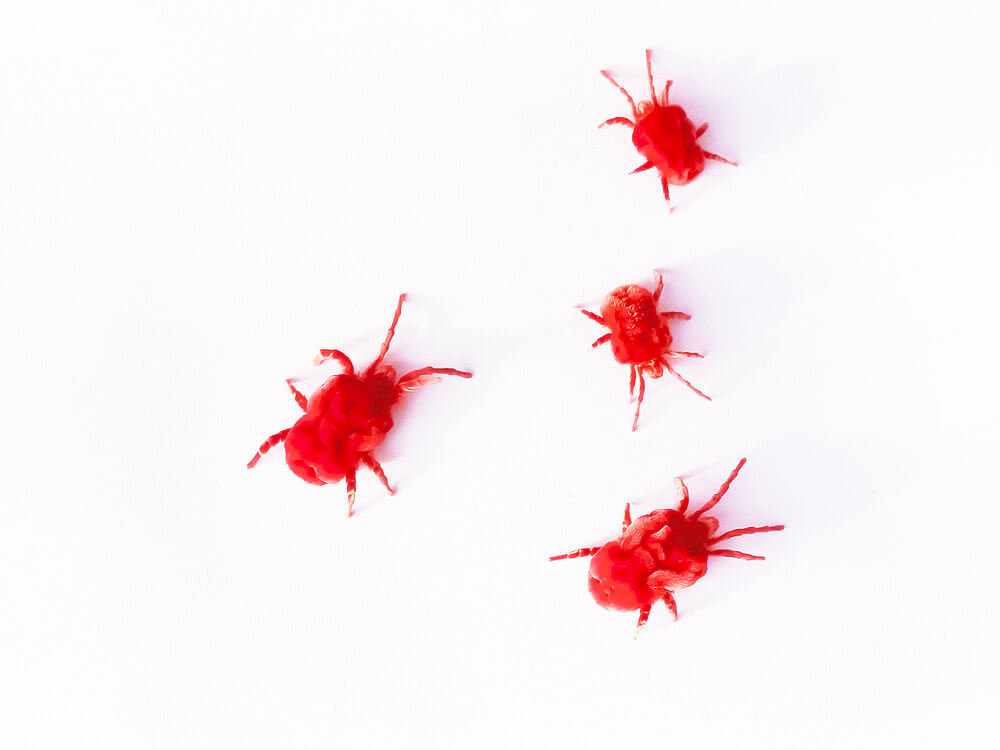
Identification
Clover mites are tiny arachnids that measure about 0.75 mm and are typically reddish-brown.
These little creatures often appear on window sills and walls, especially during the spring and fall seasons, when they are most active.
Due to their small size, they can be quite challenging to spot, which is why many people may not even realize they are present in their homes.
Clover mites can become a nuisance despite their size, as they tend to gather in large numbers.
It’s essential to keep an eye out for infestations and take measures to manage their presence if they invade your living space.
Health Risks
Clover mites do not pose any health risks to humans or pets, but they can be a nuisance when found in large numbers inside homes.
They may also cause damage to plants by feeding on their sap.
Extermination
Preventing clover mite infestations involves sealing off potential entry points around windows and doors and treating affected areas with insecticides.
Vacuuming can also help remove these pests from inside your home.
17. Ants (Various Species)
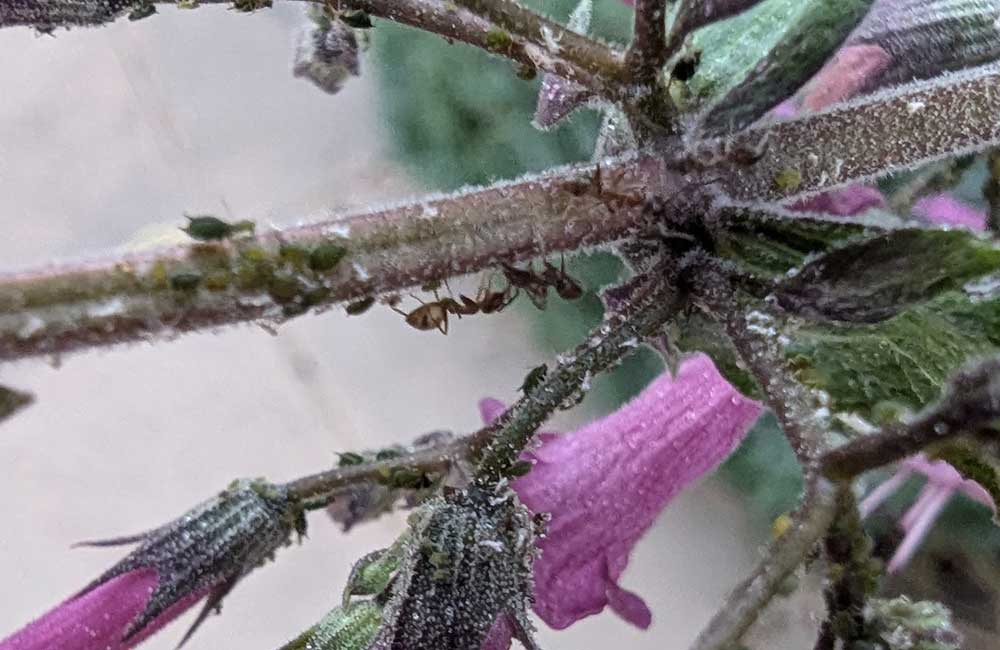
Identification
Generally, ants have a distinctive body structure composed of three main segments: the head, thorax, and abdomen, with a narrow waist connecting the thorax and abdomen.
Most ants have elbowed antennae and powerful mandibles.
Common colors include black, brown, red, and occasionally yellowish hues.
Accurately identifying the ant species is crucial for effective pest management.
Health Risks
Most ants aren’t a direct health threat to humans, but some can cause real problems.
For example, fire ants can deliver painful stings that may lead to allergic reactions in some people.
These reactions can range from mild irritation to serious anaphylactic reactions that require medical help.
Additionally, ants can contaminate food in our homes, spreading bacteria like Salmonella.
Extermination
To effectively get rid of ants, start by identifying the species, as different ants need different treatments.
Once you know the type, find and eliminate their colony using bait.
This bait contains poison that the ants will carry back to their nest, taking out the whole population.
Next, seal any entry points by caulking cracks and crevices around windows and doors to prevent more ants from entering.
Keep your space clean by wiping up food crumbs, storing food in sealed containers, and regularly taking out the trash to remove anything that might attract them.
18. Flour Beetles (Confused and Red Flour Beetle)

Identification
Flour beetles are small, reddish-brown insects often found in stored grains and flours.
They are easily distinguishable by their elongated, flattened bodies and long antennae.
The Confused Flour Beetle is about 3-4 mm long, while the Red Flour Beetle is slightly larger at 4-5 mm.
Health Risks
Like other pantry pests, these beetles can infest food products.
In addition, the dust from their shed skins and fecal matter can cause respiratory problems for people with allergies or asthma.
Extermination
To prevent floor beetle infestations, discard infested items, clean storage areas, and store grains in airtight containers.
If the infestation is severe, professional pest control services may be necessary.
19. Grain Beetles (Sawtoothed Grain Beetle)
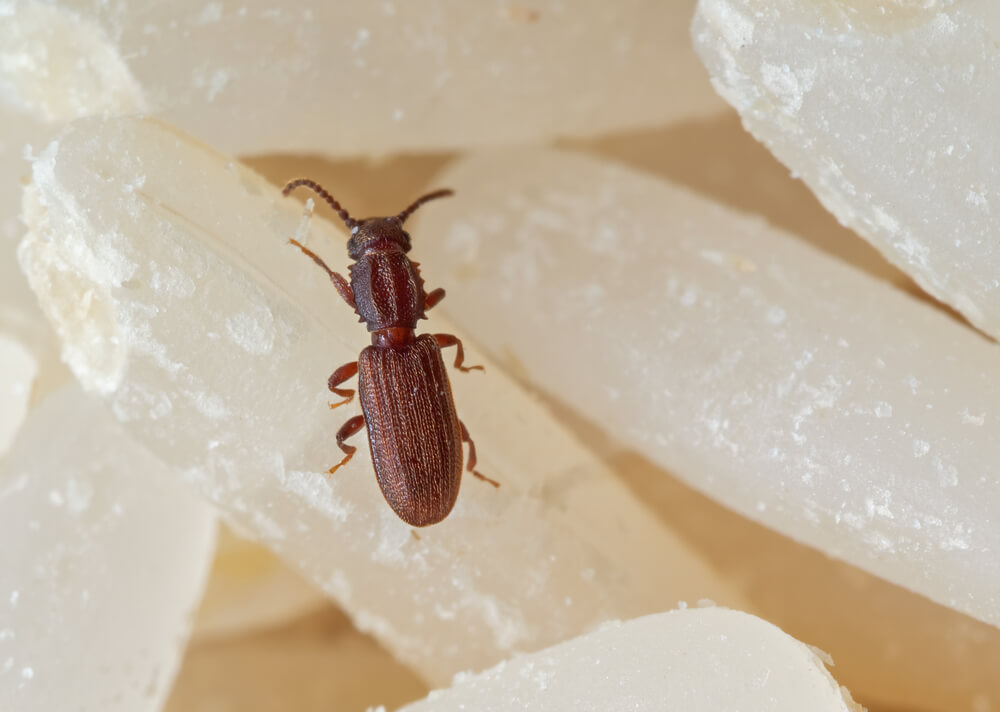
Identification
These small, flat beetles have distinctive saw-toothed edges on their bodies.
They are about 2-3 mm in length and range in color from brown to reddish-brown.
Health Risks
Grain beetles can infest a variety of stored grains and food products, causing contamination and potential health risks if consumed.
Their presence can also attract other pests, such as rodents or birds.
Extermination
Store grains in sealed containers and regularly clean storage areas to prevent grain beetle infestations.
If an infestation occurs, discard any infested items and use insecticides labeled for use on stored grains.
Professional pest control services may be necessary for severe infestations.
20. Pill Bugs (Roly-Polies)
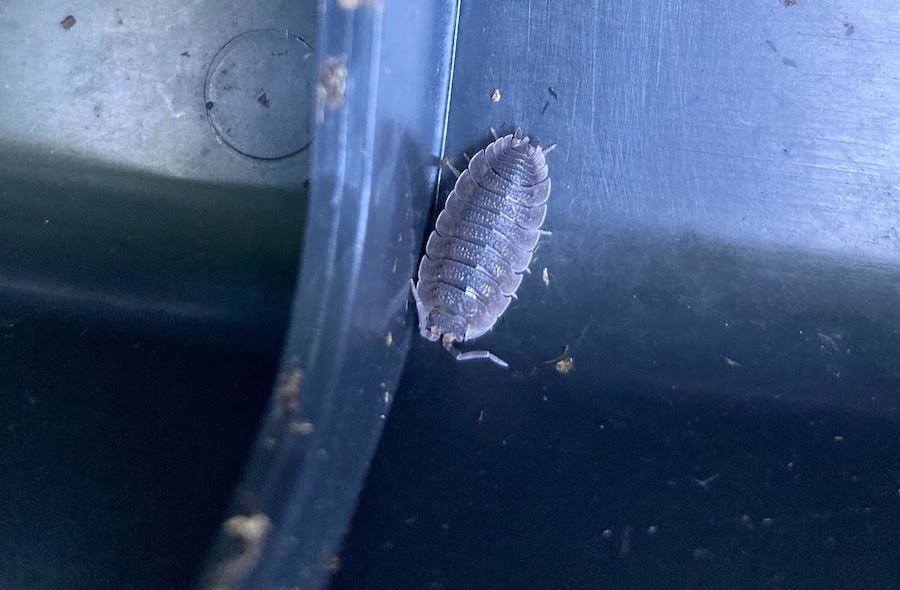
Identification
Pill bugs are small, grayish-brown bugs that can roll into a ball. They are often found in damp areas.
Health Risks
While pill bugs do not pose any direct health risks to humans, they can still be a nuisance.
They are known to damage plants and gardens, and their presence can also attract other pests.
Extermination
Removing damp areas in and around your home can help prevent infestations.
If needed, use insecticides labeled for use on pill bugs or seek professional pest control services for severe infestations.
21. Springtails

Identification
Springtails are tiny, wingless insects that are typically gray or brown. They are often found in damp environments.
Health Risks
Springtails do not pose any direct health risks to humans, but their presence can indicate a more widespread moisture issue in a home.
They are known to feed on mold and fungi, which can potentially cause damage to homes if left unchecked.
Extermination
To prevent infestations, reduce moisture levels in and around your home by fixing leaks or drainage issues.
Springtails can also be controlled with insecticides labeled for use on these insects.
Professional pest control services may be necessary for severe infestations.
22. Larder Beetles
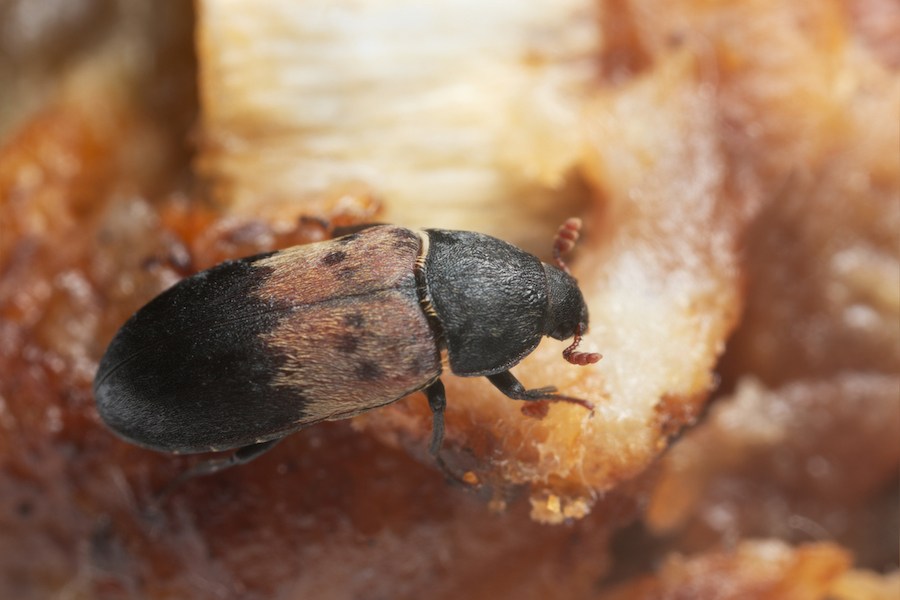
Identification
Larder beetles are dark brown with distinctive yellow markings and are often found in pantries.
They are attracted to stored food items, particularly meats and animal products.
Health Risks
Larder beetles do not pose any direct health risks, but they can contaminate food items if left unchecked.
Their presence can also attract other pests, such as carpet beetles.
Extermination
Regularly checking and rotating stored foods can help prevent infestations.
If necessary, you can use insecticides designed for larder beetles.
Professional pest control services might be needed for severe infestations.
Need Professional Extermination? We’re Here to Help!
Whether your DIY options have failed or you want faster results, working with a local pest control company is your best option.
Pest Dude has a wide network of reputable pest control professionals in your area.
Call us at (844) 532-0076, and we’ll help you get rid of any pests that are bugging you.

Get a Free Quote
Give us a call today to receive your free, no-obligation pest control quote.
